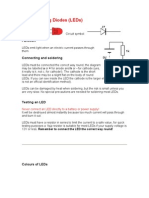Project #1 LEDs, Ohm's Law
Wikipedia Links
Resistor Light Emitting Diode (LED) Battery Ohm's Law
List of Materials
Solderless breadboard 3V, 9V or AA or AAA batteries and battery holders LED 100, 150, 220, 330, 470, 680, 1K-ohm resistors
The purpose of this project is to get you started on assemblying a prototype of a simple electronic circuit. At the same time it puts into practice simple calculations using Ohm's Law. Your power source can be any of the following:
3V coin battery 3.6V coin battery two or more 1.5V AAA or AA batteries in a 2-cell holder 9V battery
The LED will drop about 2V. Hence the series resistor has to drop the battery voltage minus 2V. We will assume that the LED drops 2V and will take 10mA. An LED will generally work fine with a current of 20mA or less. You can try reducing the current for less brightness. Avoid exceeding 20mA otherwise you may end up with a dead LED. You may want to try the calculations for lower currents such as 1mA, 2mA or 5mA and see how the brightness is affected. A 3.6V coin battery is shown as an example. Ohm's Law states that I = V/R R = V/I V = IR If the total battery voltage is 3.6V, then the voltage drop across the resistor is (3.6 - 2) = 1.6V
�Physics can be fun!
Note that the voltage drop across the LED is dependent on the colour of the light emitted by the LED. Why is this so? It's all in the physics of LEDs. Check it out!
Assume the current through the LED is 10mA or 10/1000 A = 0.010 A. Since the resistor is in series with the LED, the current flowing in the resistor is the same as that in the LED. Hence, by Ohm's Law, the value of R required is R = V/I = 1.6/0.010 = 160 ohm. Looking up our chart of standard resistor values, the closest resistance is 150 ohms. You can also try resistors of higher values which would result in a lower current and hence a less bright LED.
Tip #1
Electronics can be very forgiving most of the times. You can adjust your resistances by 20% to 50% and not notice any difference.
I will leave it up to you to fill in the blanks for the other battery voltages shown in the table below.
Battery Type 3.6V Coin 2 x 1.5V 3 x 1.5V 4 x 1.5V 9V Voltage Supply LED Voltage across R Voltage (V) (V) (V) 3.6 3 4.5 6 9 2 2 2 2 2 1.6 LED Current Calculated R Selected R (mA) (ohm) (ohm) 10 10 10 10 10 160 150
Here is the electronic schematic of the circuit. I will leave it up to you to learn about all the symbols used. All circuits and schematics were drawn and simulated using a CAD (Computer Aided Design) program called CircuitMaker. Student versions are available for download on the internet. If you are using a 9V battery, calculate the new resistance value of the resistor R1.
�Once you have calculated the required resistance for R1 and have chosen your resistor, build your circuit on the prototyping board. The LED should have a flat spot on the body of the LED indicating the cathode or negative lead. This should be connected to the negative terminal of the battery. If the LED does not light the first time, try reversing the leads. The LED will not be damaged if it is connected backwards. Congratulations! You have completed your first "Learn Electronics" project.












































































